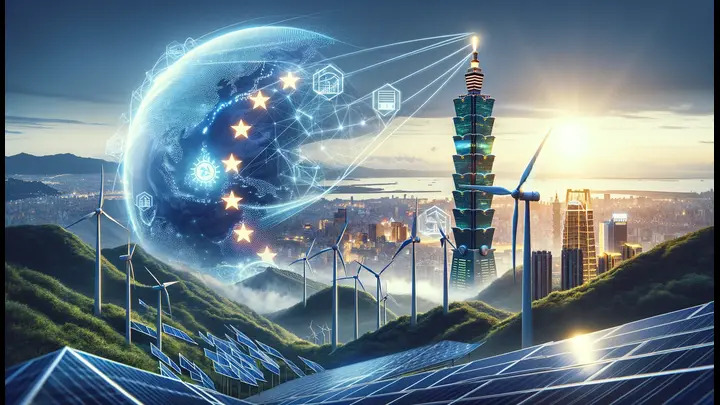Taiwan’s Energy Transition: Opportunities for Collaboration with Sweden and the EU

Brian Iselin
Taiwan has a moment now to define its future energy development. As an island nation with limited natural resources, Taiwan has historically relied heavily on imported energy sources, a practice that is neither sustainable nor economically advantageous in the long term. The global push towards sustainability, combined with the island’s unique geopolitical situation, has made the pursuit of renewable energy sources not just an environmental imperative, but a strategic necessity.
The concept of energy transition—shifting from fossil-based systems of energy production and consumption to renewable energy sources—is gaining momentum worldwide. In this context, Taiwan’s efforts are noteworthy, particularly as they align with global movements such as the European Union’s (EU) Green Agenda, which emphasises cutting greenhouse gas emissions, implementing energy-saving measures, and using more renewable energy. In this article I will also explore how Taiwan’s interaction with EU policies, especially the Emissions Trading Scheme (ETS) and the Carbon Border Adjustment Mechanism, (CBAM) presents both significant challenges and substantial opportunities. These mechanisms affect how Taiwanese industries will engage with European markets and can influence Taiwan’s own regulatory approaches to carbon emissions.
Sweden, as a part of the EU, has been a forerunner in the renewable energy transition, achieving remarkable success in integrating sustainable practices across various sectors of its economy. This article also looks at how Taiwan can leverage the experiences and successes of Sweden and the broader EU to accelerate its own energy transition. By examining the potential for collaboration in areas such as policy-making, technological innovation, and educational partnerships, this piece aims to outline a path forward that benefits not only Taiwan but also contributes to the global sustainability efforts. The engagement between Taiwan and these advanced European economies could provide a blueprint for other nations looking to make a similar transition, showcasing the mutual benefits of international cooperation in tackling one of the most pressing challenges of our times.
Taiwan’s Energy Challenges
Taiwan’s energy scenario is shaped by a confluence of geographic, economic, and political factors. As an island, Taiwan lacks sufficient indigenous energy resources, making it heavily dependent on energy imports. In 2019, over 98% of its energy was imported (Webster, 2023) , making its economy vulnerable to global oil and gas price fluctuations. This dependency not only poses economic challenges but also has strategic implications given the geopolitical tensions in the Asia-Pacific region.
Dependency on Imports
Taiwan’s reliance on imported coal, oil, and natural gas underpins its electricity generation. This dependence exposes the economy to market volatilities and supply disruptions, which can have dire consequences for national security and economic stability. The transition to renewable energy is thus not just an environmental issue but a strategic imperative for reducing this vulnerability.
Energy Mix and Environmental Impact
The current energy mix in Taiwan heavily favours fossil fuels, which accounted for approximately 79% of its total energy consumption in 2020 (Ritchie & Roser, 2022). The extensive use of these fuels has led to significant environmental degradation, including air pollution and high per capita CO2 emissions. Transitioning to a cleaner energy mix is crucial for Taiwan to meet its international commitments on climate change and to improve air quality for its residents. Taiwan’s CO2 emissions have shown varying trends over the past decades. Historically, the emissions have increased from 41.59 million metric tons in 1973 to a peak of 292.30 million metric tons in 2017. However, recent years have seen a slight decrease, with 2022 recording emissions of 278.20 million metric tons, down from 286.20 million metric tons in 2021, marking a 2.80% decrease. The current emissions statistics indicate that Taiwan’s CO2 emissions per capita were approximately 11.73 tons in 2016, reflecting a general upward trend in per capita emissions over the years. (Ycharts, 2023) Looking ahead, Taiwan has set an ambitious target to achieve net-zero carbon emissions by 2050.
The Role of Renewable Energy
Despite the many challenges, Taiwan has made strides in renewable energy development, particularly in solar and wind power. The government has set ambitious targets to increase the share of renewables – and nationally net zero – in its energy mix to 20% by 2025 (up from just 5% in 2020) (MOEA, n.d.). Achieving this will require substantial investment in technology, infrastructure, and human capital. It also necessitates overcoming regulatory hurdles and finding ways to integrate intermittent energy sources into the existing grid reliably.
Political and Economic Influences
The energy policy in Taiwan is also influenced by its unique political status. The lack of formal diplomatic relationships with most nations complicates international cooperation and access to technology that could otherwise facilitate a smoother transition to renewables. Economically, the government faces the challenge of balancing investment in renewable energy infrastructure with the immediate costs associated with such transitions, particularly in a politically sensitive environment where energy prices impact public opinion and electoral outcomes.
Rising Tensions with China
The escalating geopolitical tensions between Taiwan and China significantly impact Taiwan’s energy security and its efforts towards energy transition. As China asserts more pressure, Taiwan’s need to diversify its energy sources and reduce dependency on imports becomes more acute. This geopolitical backdrop heightens the strategic importance of Taiwan’s collaboration with international partners like Sweden and the EU, offering not only technological and economic benefits but also enhancing Taiwan’s geopolitical stability. By deepening ties with European nations, Taiwan can mitigate some of the risks associated with its geopolitical situation, ensuring more stable energy supplies and fostering an environment conducive to the adoption of sustainable energy technologies. This strategic diversification also sends a strong signal about Taiwan’s commitment to international norms and its proactive stance in securing a sustainable and autonomous energy future.
Taiwan’s energy imports are significantly vulnerable to potential disruptions by China due to its heavy reliance on imported energy, particularly maritime imports. This reliance places Taiwan at a strategic disadvantage, especially given its geographical proximity to China and the tense political relations between the two.
One of the most effective ways China could leverage this vulnerability to harm Taiwan would be through a maritime blockade – and we can assume this is one of China’s first moves in a war. Such a blockade would prevent shipments of crucial energy supplies from reaching Taiwan, effectively throttling its economy and potentially crippling its manufacturing sector.
China’s potential tactics could range from a total blockade to more selective measures that restrict specific types of goods or apply intermittent pressures. This could force international shipping to reroute, significantly increasing costs and insurance premiums, thereby escalating economic and operational burdens on Taiwan. Taiwan’s military, like its economy, heavily relies on imported energy, primarily fossil fuels. In the event of a maritime blockade by China, Taiwan’s military operations would face significant challenges due to disruptions in these critical energy supplies. A blockade could potentially cut off Taiwan’s access to oil, natural gas, and coal imports, which are vital for powering military and naval operations, as well as air and ground transport capabilities.
The People’s Liberation Army (PLA) of China has developed capabilities specifically to perform localised joint blockades against Taiwan’s critical harbors, airports, and outbound flight routes, directly threatening the flow of military supplies and logistic resources. Such a blockade would be aimed at severing Taiwan’s air and sea lines of communication, thereby impacting the military’s operational abilities (Global Taiwan Institute; The Diplomat).
Given this scenario, Taiwan’s military would indeed be critically hampered by a Chinese maritime blockade. The blockade could effectively isolate the island, making it challenging to sustain military readiness without access to these vital energy resources. The geopolitical situation underscores the importance of Taiwan developing more robust contingency plans, diversifying its energy sources, and possibly maintaining higher reserves of critical fuels to mitigate the risks posed by potential Chinese coercive strategies (Global Taiwan Institute, 2021; The Diplomat, 2023).
Political considerations aside, given the role of Taiwan in the world’s semiconductor supply chain, the EU and Sweden helping Taiwan build “energy resilience” to be able to power its military for a response to China is an acute strategic imperative.
The EU’s Green Agenda and Sweden’s Energy Model
The EU Green Agenda
The European Union has been a pioneer in promoting sustainable energy practices through its comprehensive environmental policy, the Green Agenda. Central to this agenda is the same commitment as Taiwan to become carbon-neutral by 2050—a goal that is supported by stringent regulatory measures, substantial investment in green technologies, and a shift towards a more sustainable economic model. This agenda includes initiatives like the European Green Deal, which aims to decouple economic growth from resource use while ensuring no person and no place is left behind.
Sweden’s Approach to Renewable Energy
Sweden is often cited as a model for successful energy transition. It has one of the highest rates of renewable energy usage in the world, with more than half of its energy supply coming from renewables, thanks to its investments in hydroelectric, wind, and bioenergy technologies. Sweden’s energy policy framework encourages innovation, supports energy efficiency, and aims for a 100% renewable electricity generation by 2040, and net zero by 2045. The Swedish example is particularly relevant for Taiwan due to similarities in industrial structure and economic scale.
Implications of the EU’s Emissions Trading Scheme and Carbon Border Adjustment Mechanism on EU-Taiwan Collaboration
EU’s Emissions Trading Scheme (ETS)
The EU’s Emissions Trading Scheme (ETS) is the world’s largest carbon trading system, covering more than 11,000 power stations and industrial plants in the EU, as well as airlines. The ETS sets caps on the amount of greenhouse gases that can be emitted, allowing companies to buy or sell permits to balance out their emissions. For Taiwan, the ETS presents an opportunity to learn from a mature system and potentially develop similar mechanisms that could incentivise reductions in carbon emissions. As Taiwan seeks to enhance its renewable energy capacity, the ETS model offers valuable insights into market-driven approaches to emission reductions.
Carbon Border Adjustment Mechanism (CBAM)
The introduction of the Carbon Border Adjustment Mechanism (CBAM) (NB: this is the topic of my forthcoming policy brief on the opportunities and challenges for Taiwan) by the EU marks a significant shift in global trade dynamics regarding environmental standards. CBAM is designed to adjust the prices of goods entering the EU market based on their carbon content, effectively putting a carbon price on imports to ensure that ambitious climate action in Europe does not lead to ‘carbon leakage’. This could pose a challenge for Taiwanese exporters, particularly those in high-emission industries such as steel, aluminium, and cement, who may face increased costs when exporting to the EU.
Challenges:
- Increased Costs for Exporters: Taiwanese companies exporting to the EU might incur additional costs under CBAM, making their products less competitive unless they adopt greener production methods. As will be discussed in my policy brief on the impact of CBAM, an additional path for Taiwan is onshoring in the EU, as TSMC is now doing in Germany.
- Adaptation to New Standards: Adapting to CBAM will require Taiwanese industries to invest in cleaner technologies, which might be financially burdensome in the short term but beneficial in the long run.
Opportunities:
- Driving Innovation: The need to comply with CBAM can drive innovation in cleaner industrial processes and renewable energy technologies among Taiwanese companies.
- Enhanced Market Access: By aligning with EU standards, Taiwanese products could appeal more to environmentally conscious consumers, potentially enhancing market access not only in Europe but globally.
- Collaborative Projects: CBAM can act as a catalyst for joint projects focused on reducing carbon footprints, such as collaborations on carbon capture and storage (CCS) technologies or renewable energy deployments.
Strategic Recommendations
To mitigate the challenges posed by CBAM and leverage the opportunities arising from both ETS and CBAM, Taiwan can:
- Develop Domestic Carbon Pricing Mechanisms: Learning from the EU’s ETS to establish similar frameworks that could eventually integrate with international systems.
- Invest in Clean Technology: Prioritise investments in technology that reduces carbon emissions to align with international standards and respond positively to CBAM-related costs.
- Engage in Policy Dialogues: Actively engage with EU policymakers to ensure that Taiwanese interests are considered in the ongoing evolution of the CBAM and ETS regulations.
Technological Innovation
Sweden’s success in renewable energy is largely driven by technological innovation and a supportive policy environment that fosters research and development. The country is home to numerous startups and established companies that specialise in green technologies, including smart grid solutions, energy storage, and renewable integration systems.
Governmental and Public Support
Swedish governmental policies have effectively encouraged public and private sector investment in renewables. Public support for sustainability initiatives is also robust, which facilitates smoother implementation of governmental policies. This societal consensus on the importance of environmental sustainability is something Taiwan can aspire to replicate, ensuring public buy-in for large-scale energy transitions.
Opportunities for Taiwan-EU Collaboration
Taiwan’s energy transition presents a unique opportunity for collaboration with the EU and Sweden, leveraging their advanced technologies, policy frameworks, and research capabilities. These collaborations can take various forms and could significantly accelerate Taiwan’s energy transition.
Policy Exchange and Best Practices
One of the primary areas for cooperation is the exchange of policy and best practices. Sweden’s regulatory frameworks and policies that have successfully incentivised renewable energy adoption could serve as models for Taiwan. Learning from the EU’s approach to integrating environmental sustainability into economic and industrial policies could help Taiwan develop regulations that encourage investment in green technologies while also fostering economic growth.
Technological Cooperation
Sweden and the EU are at the forefront of technological innovation in energy systems, particularly in renewable energy technologies, smart grids, and energy storage solutions. Taiwan can benefit from direct technology transfers, joint ventures, and cooperative research and development projects. These collaborations can help Taiwan overcome some of the technical challenges in its energy transition, such as integrating renewable energy sources into its national grid.
Educational and Research Exchanges
Further collaboration could be fostered through educational and research exchanges. Taiwanese and European universities and research institutions could partner to conduct joint research on sustainable energy technologies. Such partnerships could also extend to student and faculty exchanges, which would help build long-term academic and professional connections between Taiwan and the EU.
Economic Benefits
The economic benefits of Taiwan-EU collaboration in energy transition could be substantial. For Taiwan, accessing cutting-edge European technologies and expertise could help reduce the costs associated with renewable energy deployment and improve the efficiency of new technologies. For the EU and Sweden, Taiwan represents a valuable partner and market in Asia, particularly as they look to export their renewable energy technologies and expand their influence in sustainable development globally.
Strategic Initiatives
To operationalise these opportunities, strategic initiatives could include setting up bilateral commissions, funding joint research and innovation projects, and creating platforms for policy dialogue and technological exchange. These efforts would require active engagement from both governmental and private sectors, with a focus on long-term commitments and shared goals.
Strategic Approaches to Collaboration
Collaboration between Taiwan, Sweden, and the EU in the field of energy transition can be structured through several strategic approaches. These strategies aim to enhance the effectiveness of partnerships, overcome obstacles, and maximise the mutual benefits of cooperation.
Joint Research and Development Programs
Establishing joint research and development programs can foster innovation in clean energy technologies. Such programs could focus on areas where Taiwan and Sweden have complementary expertise, such as advanced battery technologies, solar energy efficiency, or offshore wind power solutions. Funding could be secured through a combination of governmental grants, EU funding instruments, and private sector contributions.
Co-Investment in Energy Projects
Co-investment in large-scale energy projects could be a practical approach to collaboration. These projects might include the development of smart grids, large-scale solar farms, or offshore wind installations. Co-investment not only shares the financial risks but also enhances the transfer of technology and expertise between the partners.
Policy Dialogues and Workshops
Regular policy dialogues and workshops involving stakeholders from Taiwan, Sweden, and other EU countries could help align strategies and policies, facilitate knowledge exchange, and foster regulatory environments conducive to energy transition. These interactions could also help to resolve misunderstandings and align goals across different governmental levels and sectors.
Addressing Challenges
- Regulatory Barriers: Differing regulatory standards can be a significant hurdle. Establishing a common framework or mutual recognition agreements on standards and certifications can ease these challenges.
- Intellectual Property Issues: Collaborative agreements need to ensure a balanced approach to intellectual property (IP) rights to encourage innovation while protecting the rights of creators.
- Cultural and Administrative Differences: Differences in administrative practices and business cultures can impede cooperation. Cultural exchange programs and joint training sessions could help bridge these gaps.
Potential Solutions
- Bilateral Trade Agreements: Enhancing bilateral trade agreements to include specific clauses that support cooperation on renewable energy projects can provide a legal and economic framework for collaboration.
- Technology Sharing Platforms: Creating platforms for technology sharing that respect IP rights can facilitate the safe exchange of technology and expertise.
- Capacity Building Initiatives: Investing in capacity building in Taiwan through workshops, training programs, and educational exchanges can ensure that the workforce is equipped to handle new technologies and concepts introduced through international cooperation.
Conclusion
Taiwan’s energy transition represents a vital step towards sustainable development and energy security for the island nation. By forging strategic partnerships with Sweden and the broader European Union, Taiwan can accelerate its transition to renewable energy, leveraging cutting-edge technology, robust policy frameworks, and extensive research collaboration. Such cooperation not only aligns with global environmental goals but also provides substantial economic, social, and strategic benefits to all parties involved.
The introduction of the EU’s Emissions Trading Scheme and the Carbon Border Adjustment Mechanism poses unique challenges but also opens up significant opportunities for Taiwan. These mechanisms can serve as both a model and a motivator for Taiwan to enhance its own regulatory frameworks and adopt advanced sustainable technologies. By aligning with these EU policies, Taiwan can mitigate risks of carbon leakage and position itself as a competitive player in a greener global economy.
Summary of Opportunities
- Policy Exchange: Taiwan can gain from Sweden’s regulatory experience and the EU’s comprehensive approach to integrating sustainability into national policy.
- Technological Cooperation: Direct technology transfers and joint ventures with European partners can address Taiwan’s technical challenges in energy integration and efficiency.
- Educational and Research Collaboration: Partnerships with EU academic institutions can foster innovation and ensure the long-term sustainability of Taiwan’s energy initiatives.
Call to Action
- For Policymakers: It is imperative that Taiwan’s policymakers facilitate and support these international collaborations through favourable policies, investment in bilateral projects, and active participation in international policy dialogues.
- For Industry Leaders: Private sectors in Taiwan, Sweden, and across the EU should explore joint investment opportunities, participate in technology exchanges, and contribute to research and development efforts.
- For Academia: Educational institutions must continue to drive research and foster educational exchanges that equip the next generation of engineers, policymakers, and business leaders with the skills necessary to succeed in a renewable energy-driven world.
The path forward for Taiwan’s energy transition is rich with opportunities for international collaboration, opportunities that are not so much choices as strategic imperatives for all three parties. By embracing these opportunities, Taiwan can not only meet its own sustainability goals but also contribute to the global effort against climate change. For Sweden and the broader EU, engaging with Taiwan offers a chance to expand their influence in Asian markets, build a hedge against supply chain disruption (not to mention defend one of the world’s most thriving democracy) by improving Taiwan’s self-reliance, and lead global advancements in renewable energy technologies
References:
Chepeliev, M. (2021). Possible Implications of the European Carbon Border Adjustment Mechanism for Ukraine and Other EU Trading Partners. Energy Research Letters. Available at: https://erl.scholasticahq.com/article/21527-possible-implications-of-the-european-carbon-border-adjustment-mechanism-for-ukraine-and-other-eu-trading-partners
The Diplomat. (2023). Taiwan’s greatest vulnerability is its energy supply. Retrieved from https://thediplomat.com
Gao, A., Fan, C., & Liao, C. (2018). Application of German energy transition in Taiwan: A critical review of unique electricity liberalisation as a core strategy to achieve renewable energy growth. Energy Policy. https://doi.org/10.1016/J.ENPOL.2018.01.010
Global Taiwan Institute. (2021). Taiwan’s energy security and the threat of a PRC blockade. Retrieved from https://globaltaiwan.org
Jhou, S. T., & Liao, H.-C. (2013). Taiwan’s severe energy security challenges. Brookings Institution. Retrieved from https://www.brookings.edu/articles/taiwans-severe-energy-security-challenges/
Kirkland, B. (2023). Diversifying the transition to renewable energy in Taiwan. Open Access Government. https://doi.org/10.56367/oag-039-10532
Kung, C., & McCarl, B. (2020). The potential role of renewable electricity generation in Taiwan. Energy Policy, 138, 111227. https://doi.org/10.1016/j.enpol.2019.111227
Ministry of Economic Affairs, R.O.C. (n.d.). Energy transition promotion scheme. Retrieved from Available at: https://www.moea.gov.tw/MNS/english/Policy/Policy.aspx?menu_id=32904&policy_id=19
Ritchie, H., Roser, M., & Rosado, P. (2022). Energy. Our World in Data. Retrieved from https://ourworldindata.org/energy
U.S.-Taiwan Business Council. (2021, June 30). 2021 Energy report. Available at: https://www.us-taiwan.org/wp-content/uploads/2021/06/2021.06.30-Energy-Report-Final.pdf
Webster, J. (2023). Does Taiwan’s massive reliance on energy imports put its security at risk? Atlantic Council. Retrieved from https://www.atlanticcouncil.org/blogs/new-atlanticist/does-taiwans-massive-reliance-on-energy-imports-put-its-security-at-risk/
YCharts. (2023). Taiwan carbon dioxide emissions. Retrieved from https://ycharts.com/indicators/taiwan_carbon_dioxide_emissions
Related Publications
-
The US and EU, and the Emerging Supply Chain Network: Politics, Prospects, and Allies
The Global Supply Chains have evolved from simply logistical achievements to being the bedrock of the global economy. Driven by technological advances and geopolitical shifts, this transformation underscores the critical […]
-
Taiwan-PRC Crisis: What Cross-Strait Conflict Could Cost Europe
The escalating tensions between Taiwan and China pose significant economic and strategic challenges to the European Union, such as the inaccessibility of Taiwanese inputs, market, and capital. This issue brief […]
-
EU-Thailand FTA Negotiations: IUU Fishing and Human Rights Remain Obstacles
Thailand’s fishing industry, which at its height saw as many as 200,000 migrant workers from neighboring Laos, Myanmar, and Cambodia caught in a brutal system of abuse, withered global criticism […]
-
ISDP Annual Report 2023
ISDP’s Annual Report for the year 2023. We look back on 2023, a year in which tensions and conflicts captured the strategic space in ISDP’s focus areas, making headlines around […]
-
The Economic Leash: China’s Financial Tethers and Global Power Plays
China’s emphasis on Gross Domestic Product (GDP) growth and its integration into global markets have allowed it to wield significant influence internationally. Nonetheless, this focus on rapid expansion has created […]




